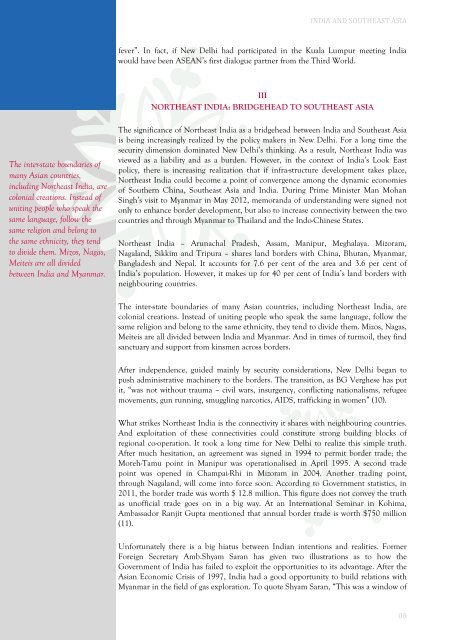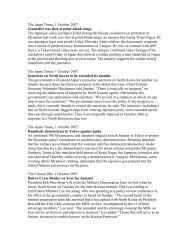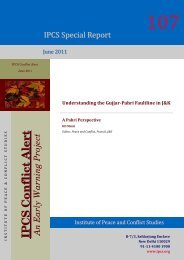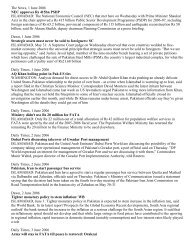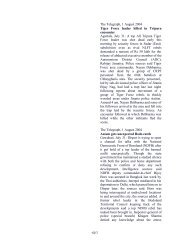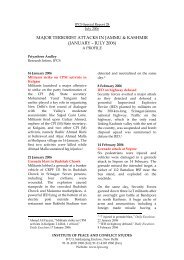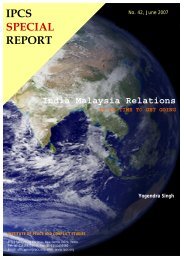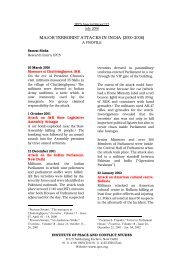India and Southeast Asia: A Personal Narrative from Chennai
India and Southeast Asia: A Personal Narrative from Chennai
India and Southeast Asia: A Personal Narrative from Chennai
You also want an ePaper? Increase the reach of your titles
YUMPU automatically turns print PDFs into web optimized ePapers that Google loves.
INDIA AND SOUTHEAST ASIA<br />
fever”. In fact, if New Delhi had participated in the Kuala Lumpur meeting <strong>India</strong><br />
would have been ASEAN’s first dialogue partner <strong>from</strong> the Third World.<br />
III<br />
NORTHEAST INDIA: BRIDGEHEAD TO SOUTHEAST ASIA<br />
The inter-state boundaries of<br />
many <strong>Asia</strong>n countries,<br />
including Northeast <strong>India</strong>, are<br />
colonial creations. Instead of<br />
uniting people who speak the<br />
same language, follow the<br />
same religion <strong>and</strong> belong to<br />
the same ethnicity, they tend<br />
to divide them. Mizos, Nagas,<br />
Meiteis are all divided<br />
between <strong>India</strong> <strong>and</strong> Myanmar.<br />
The significance of Northeast <strong>India</strong> as a bridgehead between <strong>India</strong> <strong>and</strong> <strong>Southeast</strong> <strong>Asia</strong><br />
is being increasingly realized by the policy makers in New Delhi. For a long time the<br />
security dimension dominated New Delhi’s thinking. As a result, Northeast <strong>India</strong> was<br />
viewed as a liability <strong>and</strong> as a burden. However, in the context of <strong>India</strong>’s Look East<br />
policy, there is increasing realization that if infra-structure development takes place,<br />
Northeast <strong>India</strong> could become a point of convergence among the dynamic economies<br />
of Southern China, <strong>Southeast</strong> <strong>Asia</strong> <strong>and</strong> <strong>India</strong>. During Prime Minister Man Mohan<br />
Singh’s visit to Myanmar in May 2012, memor<strong>and</strong>a of underst<strong>and</strong>ing were signed not<br />
only to enhance border development, but also to increase connectivity between the two<br />
countries <strong>and</strong> through Myanmar to Thail<strong>and</strong> <strong>and</strong> the Indo-Chinese States.<br />
Northeast <strong>India</strong> – Arunachal Pradesh, Assam, Manipur, Meghalaya. Mizoram,<br />
Nagal<strong>and</strong>, Sikkim <strong>and</strong> Tripura – shares l<strong>and</strong> borders with China, Bhutan, Myanmar,<br />
Bangladesh <strong>and</strong> Nepal. It accounts for 7.6 per cent of the area <strong>and</strong> 3.6 per cent of<br />
<strong>India</strong>’s population. However, it makes up for 40 per cent of <strong>India</strong>’s l<strong>and</strong> borders with<br />
neighbouring countries.<br />
The inter-state boundaries of many <strong>Asia</strong>n countries, including Northeast <strong>India</strong>, are<br />
colonial creations. Instead of uniting people who speak the same language, follow the<br />
same religion <strong>and</strong> belong to the same ethnicity, they tend to divide them. Mizos, Nagas,<br />
Meiteis are all divided between <strong>India</strong> <strong>and</strong> Myanmar. And in times of turmoil, they find<br />
sanctuary <strong>and</strong> support <strong>from</strong> kinsmen across borders.<br />
After independence, guided mainly by security considerations, New Delhi began to<br />
push administrative machinery to the borders. The transition, as BG Verghese has put<br />
it, “was not without trauma – civil wars, insurgency, conflicting nationalisms, refugee<br />
movements, gun running, smuggling narcotics, AIDS, trafficking in women” (10).<br />
What strikes Northeast <strong>India</strong> is the connectivity it shares with neighbouring countries.<br />
And exploitation of these connectivities could constitute strong building blocks of<br />
regional co-operation. It took a long time for New Delhi to realize this simple truth.<br />
After much hesitation, an agreement was signed in 1994 to permit border trade; the<br />
Moreh-Tamu point in Manipur was operationalised in April 1995. A second trade<br />
point was opened in Champai-Rhi in Mizoram in 2004. Another trading point,<br />
through Nagal<strong>and</strong>, will come into force soon. According to Government statistics, in<br />
2011, the border trade was worth $ 12.8 million. This figure does not convey the truth<br />
as unofficial trade goes on in a big way. At an International Seminar in Kohima,<br />
Ambassador Ranjit Gupta mentioned that annual border trade is worth $750 million<br />
(11).<br />
Unfortunately there is a big hiatus between <strong>India</strong>n intentions <strong>and</strong> realities. Former<br />
Foreign Secretary Amb.Shyam Saran has given two illustrations as to how the<br />
Government of <strong>India</strong> has failed to exploit the opportunities to its advantage. After the<br />
<strong>Asia</strong>n Economic Crisis of 1997, <strong>India</strong> had a good opportunity to build relations with<br />
Myanmar in the field of gas exploration. To quote Shyam Saran, “This was a window of<br />
08


